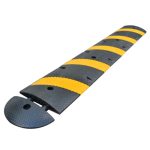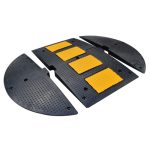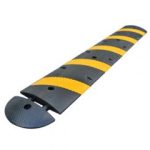Introduction
Rubber speed bumps are an effective traffic calming solution that helps to reduce the speed of vehicles in areas where pedestrian safety is a concern. However, these speed bumps can be difficult to see at night or in low light conditions, which can increase the risk of accidents. This is where reflectors come in. Reflectors are small, highly reflective devices that can be attached to rubber speed bumps to increase their visibility. In this article, we will discuss the importance of reflectors on rubber speed bumps and how they can help to improve road safety.
Enhanced Visibility
Enhanced Visibility: Reflectors on rubber speed bumps are essential for enhancing visibility, especially during low light conditions. The reflective strips on the speed bumps reflect light from headlights, making them visible from a distance. This is particularly important in areas with heavy traffic or where pedestrians frequently cross the road. Reflectors also help to prevent accidents by alerting drivers to the presence of speed bumps, reducing the risk of collisions and damage to vehicles. Additionally, the enhanced visibility provided by reflectors ensures that emergency vehicles can easily locate speed bumps, allowing them to respond quickly to emergencies. Overall, the addition of reflectors to rubber speed bumps is a simple yet effective way to improve safety on the roads.
Increased Safety
Reflectors on rubber speed bumps are crucial for increasing safety on roads and in parking lots. By reflecting light from headlights, these reflectors make speed bumps more visible to drivers, especially at night or in low-light conditions. This increased visibility helps drivers to slow down and navigate the speed bump safely, reducing the risk of accidents and injuries. Additionally, reflective speed bumps can help to improve pedestrian safety by making them more visible to drivers and alerting them to the presence of crosswalks or other pedestrian areas. Overall, the addition of reflectors to rubber speed bumps is a simple yet effective way to enhance safety on roads and in parking lots.
Legal Requirements
Legal Requirements: Reflectors on rubber speed bumps are not just a matter of safety, but also a legal requirement in many jurisdictions. In the United States, the Manual on Uniform Traffic Control Devices (MUTCD) mandates that all speed bumps must have reflective markings to increase visibility at night or in low-light conditions. Similarly, in the United Kingdom, the Department for Transport requires that all speed bumps on public roads must have reflective markings. Failure to comply with these regulations can result in fines or legal liability in the event of an accident. Therefore, it is essential to ensure that any rubber speed bumps installed on public roads or in private parking lots comply with the relevant legal requirements for reflectors.
Conclusion
In conclusion, reflectors on rubber speed bumps are an essential safety feature that should not be overlooked. They provide increased visibility for drivers, especially in low-light conditions, and help to prevent accidents and injuries. By incorporating reflectors into the design of rubber speed bumps, traffic flow can be effectively controlled while ensuring the safety of all road users. It is important for municipalities and private organizations to prioritize the installation of reflectors on rubber speed bumps to promote safe driving practices and reduce the risk of accidents.
Next Steps: Invest in Reflective Rubber Speed Bumps Now that you understand the importance of reflectors on rubber speed bumps, it’s time to take action. At Unimat Industries, we offer a variety of high-quality rubber speed bumps with reflective strips that are designed to enhance safety and visibility in any setting. Whether you’re looking to improve traffic flow in a parking lot, slow down drivers in a residential area, or enhance safety in a school zone, our speed bumps are the perfect solution. Visit our website today to explore our selection of speed bumps and take the next step towards a safer, more efficient environment.






